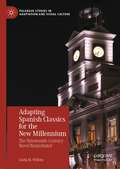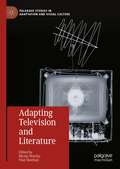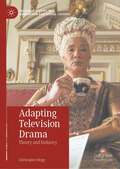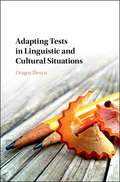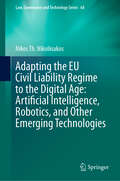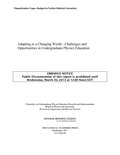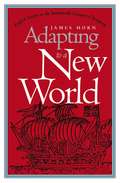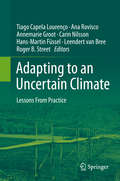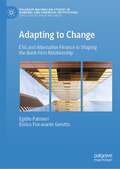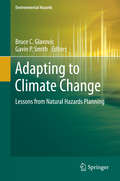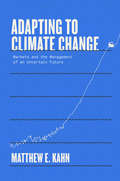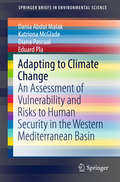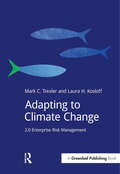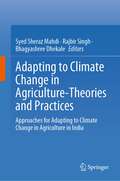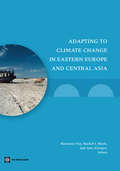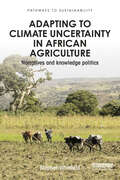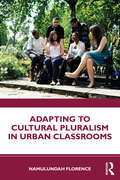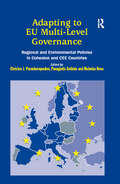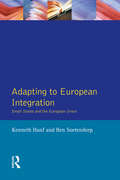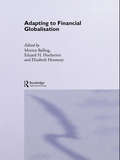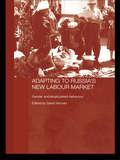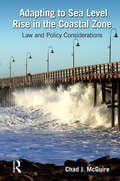- Table View
- List View
Adapting Spanish Classics for the New Millennium: The Nineteenth-Century Novel Remediated (Palgrave Studies in Adaptation and Visual Culture)
by Linda M. WillemThe twenty-first-century's turn away from fidelity-based adaptations toward more innovative approaches has allowed adapters from Spain, Argentina, and the United States to draw upon Spain's rich body of nineteenth-century classics to address contemporary concerns about gender, sexuality, race, class, disability, celebrity, immigration, identity, social justice, and domestic violence. This book provides a snapshot of visual adaptations in the first two decades of the new millennium, examining how novelistic material from the past has been remediated for today's viewers through film, television, theater, opera, and the graphic novel. Its theoretical approach refines the binary view of adapters as either honoring or opposing their source texts by positing three types of adaptation strategies: salvaging (which preserves old stories by giving them renewed life for modern audiences), utilizing (which draws upon a pre-existing text for an alternative purpose, building upon the story and creating a shift in emphasis without devaluing the source material), and appropriation (which involves a critique of the source text, often with an attempt to dismantle its authority). Special attention is given to how adapters address audiences that are familiar with the source novels, and those that are not. This examination of the vibrant afterlife of classic literature will be of interest to scholars and educators in the fields of adaptation, media, Spanish literature, cultural studies, performance, and the graphic arts.
Adapting Television and Literature (Palgrave Studies in Adaptation and Visual Culture)
by Blythe Worthy Paul SheehanAdapting Television and Literature is an incisive collection of essays that explores the growing sub-category of television adaptations of literature and poetics. Each chapter questions inflexible notions of film / literature and adaptation / intertext, focusing judiciously on emergent or overlooked media and literary forms. These lines of enquiry embrace texts both within and beyond ‘adaptation proper’, to reveal the complex relationships between literary works, television adaptations, and related dialogues of textual interconnectivity. Adapting Television and Literature proposes, in particular, a ‘re-seeing’ of four genres pivotal to television and its history: caustic comedy, which claims for itself more freedoms than other forms of scripted television; auteurist outlaw drama, an offbeat, niche genre that aligns a fixation on lawbreakers with issues of creative control; young adult reinventions that vitalise this popular, yet under-examined area of television studies; and transcultural exchanges, which highlight adaptations beyond the white, Anglo-American programming that dominates ‘peak TV’. Through these genres, Adapting Television and Literature examines the creative resources of adaptation, plotting future paths for enquiries into television, literature and transmedial storytelling.
Adapting Television Drama: Theory and Industry (Palgrave Studies in Adaptation and Visual Culture)
by Christopher HoggThis book explores adaptation in its various forms in contemporary television drama. It considers the mechanics of adaptation as an ever-more prevalent form of production, most notably in the reworking of literary sources for television. It also explores the broader process through which the television industry as a whole is currently making necessary adaptations in how it tells stories, especially in relation to important concerns of equality, diversity and inclusion. Offering and analysing 16 original interviews with leading British television producers, writers, directors, production designers, casting directors and actors, and with a particular focus on female and/or minority-ethnic industry perspectives, the book examines some of the key professional and creative approaches behind television adaptations today. The book connects these industry insights to the existing conceptual and critical frameworks of television studies and adaptation studies, illuminating the unique characteristics of television adaptation as a material mode of production, and revealing television itself as an inherently adaptive artform.
Adapting Tests in Linguistic and Cultural Situations (Educational and Psychological Testing in a Global Context)
by Dragoş IliescuThis book explores test adaptation, a scientific and professional activity now spanning all of the social and behavioural sciences. Adapting tests to various linguistic and cultural contexts is a critical process in today's globalized world, and requires a combination of knowledge and skills from psychometrics, cross-cultural psychology and others. This volume provides a step-by-step approach to cross-cultural test adaptation, emphatically presented as a mélange between science and practice. The volume is driven by the first-hand practical experience of the author in a large number of test adaptation projects in various cultures, and is supported by the consistent scientific body of knowledge accumulated over the last several decades on the topic. It is the first of its kind: an in-depth treatise and guide on why and how to adapt a test to a new culture in such a way as to preserve its psychometric value. Informs the practitioner by providing a complete picture of the test adaptation process. Draws upon theoretical publications and practical experience - a 'one-stop-shop' on matters related to test adaptation and translation. Presents a thoroughly researched, comprehensive perspective heretofore unrepresented in current literature.
Adapting the EU Civil Liability Regime to the Digital Age: Artificial Intelligence, Robotics, and Other Emerging Technologies (Law, Governance and Technology Series #68)
by Nikos Th. NikolinakosThis book highlights the challenges that artificial intelligence (AI), robotics, the Internet of Things (IoT), and other emerging digital technologies pose to existing EU and national liability legislation, while also tracing the evolution of the relevant EU policy and legal framework. Recognising that Member States’ current national fault-based liability rules are ill-suited to handle compensation claims for AI-related harm, the book emphasises the difficulty victims face in proving fault and causation due to AI’s unique characteristics, such as autonomy and opacity (“black box” effect). Similarly, the current Product Liability Directive (PLD) has several shortcomings: certain products, economic actors, and types of damage in the digital and circular economy are not covered under strict liability; proving defectiveness and establishing a causal link with damage, especially for complex products, is often challenging; in addition, liability claims are subject to restrictive limits and thresholds. The book discusses in detail the European Commission’s proposal for a Directive on harmonising civil liability rules for damage caused by AI systems (the ‘proposed AI Liability Directive’). It also offers a thorough analysis of the European Commission’s proposal for a revised Product Liability Directive, compares it with the positions of the Council of the EU and the European Parliament, and discusses the final text approved by the Plenary of the European Parliament in March 2024. The book incorporates comments from various parties, offering insights into the approaches of EU institutions and the conflicting interests among stakeholders. Presenting carefully grounded arguments, this volume serves as a valuable resource for understanding the interplay between policy and law within the new EU liability framework for AI and other innovative products. This forthcoming EU regime represents a significant shift in the liability landscape, potentially heightening litigation risks. Its success will depend on achieving the EU’s overarching objective: ensuring fair compensation while fostering technological innovation.
Adapting to a Changing World--Challenges and Opportunities in Undergraduate Physics Education
by National Research Council Division on Engineering and Physical Sciences Committee on Undergraduate Physics Education Research and Implementation Board on Physics and AstronomyAdapting to a Changing World was commissioned by the National Science Foundation to examine the present status of undergraduate physics education, including the state of physics education research, and, most importantly, to develop a series of recommendations for improving physics education that draws from the knowledge we have about learning and effective teaching. Our committee has endeavored to do so, with great interest and more than a little passion. The Committee on Undergraduate Physics Education Research and Implementation was established in 2010 by the Board on Physics and Astronomy of the National Research Council. This report summarizes the committee's response to its statement of task, which requires the committee to produce a report that identifies the goals and challenges facing undergraduate physics education and identifies how best practices for undergraduate physics education can be implemented on a widespread and sustained basis, assess the status of physics education research (PER) and discuss how PER can assist in accomplishing the goal of improving undergraduate physics education best practices and education policy.
Adapting to a New World
by James HornOften compared unfavorably with colonial New England, the early Chesapeake has been portrayed as irreligious, unstable, and violent. In this important new study, James Horn challenges this conventional view and looks across the Atlantic to assess the enduring influence of English attitudes, values, and behavior on the social and cultural evolution of the early Chesapeake. Using detailed local and regional studies to compare everyday life in English provincial society and the emergent societies of the Chesapeake Bay, Horn provides a richly textured picture of the immigrants' Old World backgrounds and their adjustment to life in America. Until the end of the seventeenth century, most settlers in Virginia and Maryland were born and raised in England, a factor of enormous consequence for social development in the two colonies. By stressing the vital social and cultural connections between England and the Chesapeake during this period, Horn places the development of early America in the context of a vibrant Anglophone transatlantic world and suggests a fundamental reinterpretation of New World society.
Adapting to an Uncertain Climate: Lessons From Practice
by Tiago Capela Lourenço Ana Rovisco Annemarie Groot Carin Nilsson Hans-Martin Füssel Leendert Bree Roger B. StreetClimate change highlights the challenges for long-term policy making in the face of persistent and irreducible levels of uncertainties. It calls for the development of flexible approaches, innovative governance and other elements that contribute to effective and adaptive decision-making. Exploring these new approaches is also a challenge for those involved in climate research and development of adaptation policy. The book provides a dozen real-life examples of adaptation decision making in the form of case studies: · Water supply management in Portugal, England and Wales and Hungary · Flooding, including flood risk in Ireland, coastal flooding and erosion in Southwest France, and flood management in Australia's Hutt River region · Transport and utilities, including the Austrian Federal railway system, public transit in Dresden, and Québec hydro-electric power · Report examining communication of large numbers of climate scenarios in Dutch climate adaptation workshops.
Adapting to Change: ESG and Alternative Finance in Shaping the Bank-Firm Relationship (Palgrave Macmillan Studies in Banking and Financial Institutions)
by Egidio Palmieri Enrico Fioravante GerettoThis book examines the evolving dynamics between banks and firms within the context of alternative finance and Environmental, Social, and Governance (ESG) integration. The book contributes to understanding the bank-firm relationship in light of the changing financial landscape and its implications for sustainable development. The book employs an empirical analysis to examine the bank-firm relationship in the context of alternative finance and ESG performance to assess firms’ riskiness, access to funds and cost of capital. The book addresses research gaps by comprehensively analysing the impact of alternative finance and ESG on the bank-firm relationship. It assists banks in adapting their financing practices and policies to align with emerging trends, and it offers insights for banks to evaluate and mitigate ESG-related risks effectively. It provides policy implications for promoting responsible lending, supporting the growth of alternative finance, and incentivising ESG integration in the financial sector. Ultimately, it contributes to formulating policies that foster a sustainable and inclusive financial system, and will be of interest to professionals and researchers in finance, alternative finance, and sustainable finance.
Adapting to Climate Change: Lessons from Natural Hazards Planning (Environmental Hazards)
by Bruce C. Glavovic Gavin P. SmithThis book identifies lessons learned from natural hazard experiences to help communities plan for and adapt to climate change. Written by leading experts, the case studies examine diverse experiences, from severe storms to sea-level related hazards, droughts, heat waves, wildfires, floods, earthquakes and tsunami, in North America, Europe, Australasia, Asia, Africa and Small Island Developing States. The lessons are grouped according to four imperatives: (i) Develop collaborative governance networks; (ii) build adaptive capabilities; (iii) invest in pre-event planning; and (iv) the moral imperative to undertake adaptive actions that advance resilience and sustainability. "A theoretically rich and empirically grounded analysis of the interface between disaster risk management and climate change adaptation, comprehensive yet accessible, and very timely. " Mark Pelling, Department of Geography, King's College London, UK. "This book represents a major contribution to the understanding of natural hazards planning as an urgent first step for reducing disaster risk and adapting to climate change to ensure sustainable and equitable development. " Sálvano Briceño, Vice-Chair, Science Committee, Integrated Research on Disaster Risk IRDR, an ICSU/ISSC/ISDR programme. Former Director International Strategy for Disaster Reduction, UNISDR. "What a welcome addition to the young literature on climate adaptation and hazard mitigation! Bruc e Glavovic and Gavin Smith each bring to the editing task a rare blend of solid scholarly attainment and on-the-ground experience that shines through in this extensively-documented synthesis of theoretical ideas from the realms of climate and hazards and their validation in a rich set of diverse case studies pulled in from around the world. This book should remain a classic for many years. " William H. Hooke, American Meteorological Society.
Adapting to Climate Change: Markets and the Management of an Uncertain Future
by Matthew E. KahnA revelatory study of how climate change will affect individual economic decisions, and the broad impact of those choicesSelected by Publishers Weekly as one of its Top Ten books in Business and Economics for Spring 2021 It is all but certain that the next century will be hotter than any we&’ve experienced before. Even if we get serious about fighting climate change, it&’s clear that we will need to adapt to the changes already underway in our environment. This book considers how individual economic choices in response to climate change will transform the larger economy. Using the tools of microeconomics, Matthew E. Kahn explores how decisions about where we live, how our food is grown, and where new business ventures choose to locate are impacted by climate change. Kahn suggests new ways that big data can be deployed to ease energy or water shortages to aid agricultural operations and proposes informed policy changes related to public infrastructure, disaster relief, and real estate to nudge land use, transportation options, and business development in the right direction.
Adapting to Climate Change: An Assessment of Vulnerability and Risks to Human Security in the Western Mediterranean Basin (SpringerBriefs in Environmental Science)
by Katriona Mcglade Dania Abdul Malak Diana Pascual Eduard PlaThis book examines the water-related impacts of climate change in the UNESCO Intercontinental Biosphere Reserve of the Mediterranean (IBRM) straddling Spain and Morocco. This is the first in-depth publication on a fascinating transboundary case study; while climate change effects are rather homogenous across the IBRM, differing socio-economic contexts, land-use patterns and policy frameworks in Spain and Morocco mean considerable variations in vulnerability and consequences for human security. The authors have produced a novel and integrated vulnerability assessment that combines hydro-ecological, socio-economic and policy analyses. The interdisciplinary approach and insights contained in this volume will appeal both to those interested in the integration of natural and social sciences as well as those working on water and climate change from academic, practical or policy-oriented perspectives.
Adapting to Climate Change: 2.0 Enterprise Risk Management (Doshorts Ser.)
by Mark Trexler Laura KosloffMost companies do not yet recognize what it means to adapt to future climate change, and do not yet see it as a business priority. Adapting to Climate Change tackles two key questions facing decision makers: 1) Is adaptation worth it to me? and 2) If it is worth it, can I really tackle it? If a company has reason to worry about the potential impacts of weather on its operations and supply chains, it probably has cause to worry about climate change. However, "adapting to the weather" is not the same as incorporating climate change adaptation into corporate planning. In the former a company is managing conditions they are already experiencing. The latter involves preparing for forecasted impacts of climate change. Focusing on today’s weather and not tomorrow’s climate leaves a lot of risk on the table, especially if the climate continues to change faster than many climate models have projected. The uncertainties associated with forecasting climate change on a timeframe and at a scale that is relevant to corporate decision making can appear daunting. It is not necessary, however, to have perfect information to advance corporate preparedness for and resilience to climate change. Companies can improve their ability to make robust decisions under conditions of uncertainty without perfect information. A Bayesian approach to reducing uncertainty over time can cost-effectively support companies in understanding and managing many potential climate risks and can avoid the need to depend on future predictions. Instead, initial effort can focus on where a company will have confidence in its analysis and the ability to influence its level of risk, namely in assessing its exposure and vulnerability to climate hazards. As the hazards themselves become more clear, risk management strategies can be quickly adapted.
Adapting to Climate Change in Agriculture-Theories and Practices: Approaches for Adapting to Climate Change in Agriculture in India
by Syed Sheraz Mahdi Rajbir Singh Bhagyashree DhekaleThis book brings together a series of chapters that provides updated information on adaptation practices against climate change in agriculture and livestock. Information on some new aspects like conservation of carnivorous plants, climate-smart millets production, advances in genomic interventions for climate resilient crops, perceptions on disease and pests under changing climate, role of neglected crops in climate resilient agriculture, nanotechnology in sustainable agriculture, use of crop wild relatives for developing climate resilient crops have been discussed. It also presents detailed information carbon sequestration practices and green consumption behaviour for sustainable development. The last chapter of book mentions about an innovative agronomic technique under rainfed conditions for sustainable yield advantage in soybean crop.
Adapting to Climate Change in Eastern Europe and Central Asia
by Marianne Fay Jane Ebinger Rachel BlockThe region of Eastern Europe and Central Asia (ECA) is already experiencing the consequences of climate change: increasing variability, warmer temperatures, altered hydrology. Events such as droughts, floods, heat waves, windstorms, and forest fires are increasing in number and severity. The concentration of greenhouse gases already in the atmosphere guarantees that similar or greater changes are yet to come-even if the world were to completely stop emitting CO2 today. This region is particularly vulnerable because of its legacy of socioeconomic issues, environmental mismanagement, aging infrastructure and housing, and under-investment in hydrometeorological, rural, and health institutions. The resulting adaptation deficit will exacerbate climate risks and hamper the ability of sectors that could gain from climate change, such as agriculture, to reap the full benefits. 'Adapting to Climate Change in Eastern Europe and Central Asia' presents an overview of what adaptation to climate change might mean for the countries of ECA. It starts with a discussion of emerging best-practice adaptation planning around the world and a review of the latest climate projections. It then discusses possible actions to improve resilience organized around impacts on natural resources, health, the unbuilt environment of agriculture and forestry, and the built environment of infrastructure and housing. The book concludes with a discussion of two areas in great need of strengthening: disaster preparedness and hydrometeorological services. The next decade offers a window of opportunity for ECA countries to make their development more resilient to climate change. While some impacts of climate change are already being felt, they are likely to remain manageable over the next decade, offering the ECA region a short period of time to focus on actions that have numerous benefits both today and in the future.
Adapting to Climate Uncertainty in African Agriculture: Narratives and knowledge politics (Pathways to Sustainability)
by Stephen WhitfieldFuture climatic and agro-ecological changes in Africa are uncertain and associated with high degrees of spatial and temporal variability and this change is differently simulated within divergent climate-crop models and in controlled crop breeding stations. Furthermore, uncertainty emerges in local contexts, not just in response to climatic systems, but to social, economic, and political systems, and often with implications for the appropriateness and adoption of technologies or the success of alternative cropping systems. This book examines the challenges of adaptation in smallholder farming in Africa, analysing the social, economic, political and climatic uncertainties that impact on agriculture in the region and the range of solutions proposed. Drawing on case studies of genetically modified crops, conservation agriculture, and other 'climate smart' solutions in eastern and southern Africa, the book identifies how uncertainties are framed 'from above' as well experienced 'from below', by farmers themselves. It provides a compelling insight into why ideas about adaptation emerge, from whom, and with what implications. This book offers a unique perspective and will be highly relevant to students of climate change adaptation, food security and poverty alleviation, as well as policy-makers and field practitioners in international development and agronomy.
Adapting to Cultural Pluralism in Urban Classrooms
by Namulundah FlorenceThis book helps teachers explore the origins of differing value structures in safe forums. It uses guided cross-cultural exchanges to help break down prejudices and foster an appreciation of other cultures and the essence of a common humanity. Acknowledging the inextricable link between cultural and structural factors in the plight of vulnerable student populations, this work focuses on how to help counter prevailing disparities in perceptions and expectations within school settings. Designed primarily for teacher candidates, this book offers educators a forum for recognizing the impact of primary backgrounds in teaching and learning. Adapting to Cultural Pluralism in Urban Classrooms focuses on four elements in the teaching/learning process: school climate; the views and expectations of teachers in solidarity with principals and policy makers; teacher interactions with students and parents; and the centrality of reflection to improve practice. It offers tools to support cultural adaptations that enhance the academic success of inner-city students served by predominantly white and more privileged teachers.
Adapting to EU Multi-Level Governance: Regional and Environmental Policies in Cohesion and CEE Countries
by Nicholas Rees Panagiotis Getimis Christos ParaskevopoulosThe main theme of this book is the adaptation process of the new EU member states from Central-Eastern Europe (Hungary and Poland) to the multi-level system of governance in public policy, particularly in the regional and environmental policy areas. The work conceptualizes policy learning and institutional and policy adaptation within the EU system of governance and draws lessons from the experience of previous waves of enlargement-cohesion-countries (Ireland, Portugal and Greece). In doing so, the book makes an important contribution to the literature on the transformation of domestic policy-making structures, as a result of the increasing Europeanization of public policy, as well as on the conceptual tools, explanatory variables and mechanisms determining this process.
Adapting to European Integration: Small States and the European Union
by Kenneth Hanf Ben SoetendorpAdapting to European Integration describes how the political institutions in eight small member states and two non-members responded to the internal and external demands springing from the process of European integration in general and EC/EU membership in particular. The study makes a distinction between governmental/administrative adaptation, political adaptation and strategic adaptation. The chapters focus, in the first instance, on the governmental/administrative responses at the level of central government, the organisational adjustments and the changes in institutional capacity to meet the new challenges. The authors also look at the willingness of the political decision-makers to internalise the EC/EU dimension in domestic policy making and the way in which the country's own history as well as the attitude towards European integration facilitate or hinder adaptation and change.
Adapting to Financial Globalisation (Routledge International Studies in Money and Banking #Vol. 14)
by Morten Balling Eduard H. Hochreiter Elizabeth HennessyAdapting to the demands of financial globalisation is currently one of the most pressing preoccupations of bankers, financial institutions and financial authorities. Many aspects of this issue are addressed in this volume, based on a colloquium held in Vienna in April 2000 by the Société Universitaire Européene de Rechèrches Financières (SUERF) jointly with the Austrian National Bank.Individual chapters, written by academics, central bankers and market professionals, focus on the strategic implications of global pressures which are tending to eradicate the previously clear boundaries of time, distance, legal frameworks, culture, languages and currencies.
Adapting to Online and Blended Learning in Higher Education: Supporting the Retention and Success of the Expanded and Diversified Intake
by David Kember Robert A. Ellis Si Fan Allison TrimbleHigher education has undergone a massive transformation in teaching and learning in a very short period of time since the onset of Covid-19. Students, teachers and universities have had to adopt online and blended learning, often with little or no experience or models of good practice to draw upon. It is clear that blended and online learning are here to stay. This book draws on research from universities that have adopted online and blended learning to facilitate the expansion and diversification of their intake; which resulted in considerable experience and expertise in online and blended teaching. The book describes a model, tested with qualitative and quantitative data, which shows how teachers can support the retention and success of online and blended learners with four high-quality pedagogical elements: bite-sized videos of interest and relevance; learning materials that are well organised and provide a clear learning roadmap; discussion forums which are set up and moderated so as to result in lively student-student and student-teacher interaction; and, online teachers being approachable and responsive to communication with individual students through email, phone and online communication platforms. This model is explained and profusely illustrated with examples from the teaching of award-winning teachers. This book introduces the concept of a spectrum from traditional to contemporary models of admission and course delivery in higher education. It explains how universities which have adopted a contemporary model, with high levels of blended and online learning, have been able to expand their intake and markedly diversify the student body. It discusses how to support the retention and success of online and blended learners. Student support services are examined from the perspectives of service providers and online and blended learners and the case is made for support services being aligned with student needs. The book has a discussion of university management systems which utilise feedback at all levels to improve alignment between support service provision and student needs.
Adapting to Russia's New Labour Market: Gender and Employment Behaviour (Routledge Contemporary Russia and Eastern Europe Series #Vol. 5)
by Sarah AshwinEconomic reform in post-Soviet Russia created not only a devastating decline in living standards, but also widespread insecurity and uncertainty. This book is the first to analyse the situation from a gendered perspective, shedding new light on the way in which Russians are coping with the transformation of the labour market. The book examines gender differences in responses to economic reform, and considers the implications of these for the labour market outcomes and wider well-being of men and women during transition. Based on original research carried out by an experienced team of sociologists, the book analyses the journeys of 240 men and women through the turbulent Russian labour market of 1999-2001. It includes chapters on: *the way gender norms inherited from the Soviet era have influenced responses to transition *sex segregation and discrimination in the labour market *gender differences in work orientations and behaviour *who benefits from networks *which life events are most likely to initiate downward economic trajectories.
Adapting to Sea Level Rise in the Coastal Zone: Law and Policy Considerations
by Chad J. McGuireFor as long as humans have been inhabiting coastal areas and recording what occurs in their environments, coastal zones have been defined through dynamic interactions. And this is further underlined by a more recent development: observed sea level rise. In a thorough but not overly technical approach, Adapting to Sea Level Rise in the Coastal Zone: Law and Policy Considerations provides a legal-policy framework for facing the challenges of sea level rise. The book includes an analysis of sea level rise adaptation strategies that examines the legal impacts of coastal land use decisions based on the current interpretation of private property rights in relation to public control over those rights. The author discusses the science behind sea level rise and highlights policy complexities and options. He then presents an overview of related legalities, and bringing it all together, applies the principles offered in the book, concluding with strategies and solutions and a perspective on the future. If we accept the premise that sea level rise is occurring and will continue for the foreseeable future, then we must begin to consider policy responses to this risk in coastal regions. Part of any pragmatic policy response must include a review of the options available to public institutions when developing and implementing rational adaptation policies. This book offers practical legal/policy approaches to sea level rise adaptation that promotes sound planning in the face of climate change and rising seas.
Adapting to Shorter Time Cycles in the United States Air Force: Proceedings Of A Workshop Series
by National Academies of Sciences, Engineering, and Medicine Division on Engineering and Physical Sciences Air Force Studies BoardThe Air Force Studies Board of the National Academies of Sciences, Engineering, and Medicine hosted a three-part workshop series to investigate the changing paradigm of time and knowledge in modern-day warfare. Sponsored by the U.S. Department of Defense, three 2-day workshops were held virtually on September 16-17, 2020, September 23-24, 2020, and October 1-2, 2020. The objective of the first workshop was to explore the ways in which the U.S. Air Force (USAF) has adjusted its capabilities in response to past shifts in operational timing. In consideration of these past shifts, the second workshop aimed to consider when there could be an advantage to synchronize or desynchronize rates of change with adversaries. Participants had the opportunity to discuss lessons learned and possible changes for USAF Doctrine and future operations. The goal of the third workshop was to examine the implications to doctrine, concepts of operations, and command and control from the recent acceleration of battlespace operations, arising from wide-scale digitization, large-scale sensing, and faster technologies. In all three workshops, speakers explored the broader issues surrounding changing environments, and participants discussed ways to adapt to fundamental changes in the time constants of conflict. This proceedings is a factual summary of what occurred during the workshop series.
Adapting to the Land: A History of Agriculture in Colorado
by John F. FreemanAdapting to the Land examines the extent to which Colorado agriculturists adapted to or stretched beyond the limits of land and water. Historian John F. Freeman and horticultural scientist Mark E. Uchanski document the state’s agricultural history and provide context for the shift away from traditional forms of agriculture to the use of synthetic fertilizers, herbicides, and pesticides—and, most recently, to more values-driven practices to support the burgeoning popularity of natural and organic foods. This shift has resulted in the establishment of the global organic food processing and distribution industry, which has roots in Colorado. Ancestral Puebloans farmed and grazed within the limits of nature. Early settlers adjusted their cultivation methods through trial and error, while later agriculturists relied on research and technical advice from the Colorado Agricultural College. As part of wartime mobilization, the federal government prompted farmers to efficiently increase yields. To meet the demand for food and fiber scientific and technical innovations led to the development of new plant cultivars and livestock breeds, advances in mechanization, and widespread use of synthetic amendments. Increasing concern over soil fertility and the loss of irrigation water to urbanization contributed to more changes. Despite, or perhaps because of, what we see today along the Front Range, Colorado may still have a chance to slow or even reverse its seemingly unrestrained growth, creating a more vibrant, earth-friendly society in which agriculture plays an increasingly significant part. Scientific discoveries and innovations in regenerative cultivation are clearing the path to a more sustainable future. Adapting to the Land adds an ecological and horticultural perspective to historical interpretations of recurring agricultural issues in the state and tracks the concept of stewardship, suggesting that spiritual beliefs continue to contribute to debates over acceptable agricultural practices and the effects of urbanization upon the land. This book will be a key resource for students, scholars, and general readers interested in agricultural and Colorado history, sustainability, and rural sociology.
